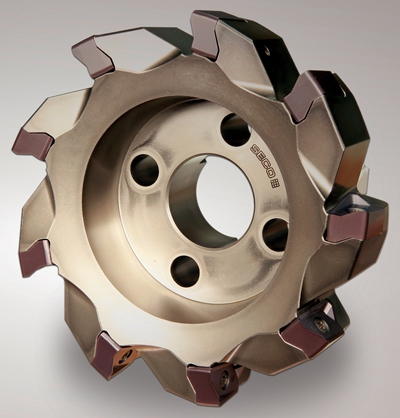
Seco Tools LLC has introduced a line of R220.LN14 square shoulder mills that reduce costs and improve performance in demanding applications that require large depths of cut.
R220.LN14 square shoulder mills provide four cutting edges with a 14mm (0.551") cutting edge length to reduce cost per edge. Negative rake, 7mm (0.28") thick inserts provide the robustness needed for heavy cuts in difficult materials, long-reach applications and less stable setups. With geometry similar to Seco's highly successful Square 6, the tools are also very free cutting.
The standard tools are able to take depths of cut up to 14mm (0.551"), while the helical versions are offered in cutting edge lengths for both contouring and slotting applications. R220.LN14 cutters are an excellent choice for medium- to heavy-duty applications requiring a 90-degree wall.
Inserts are available in six grades: MS2500, a CVD coated, highly wear-resistant and tough grade for machining superalloy materials and high-carbon steels; 420470, which provides toughness greater than MS2500; 150060, which is very similar to Seco's F40M; and 029060, an alternative to the company's MK1500 with a PVD coating; MP2500, which is a medium steel CVD Duratomic grade; and MK1500, which is a cast iron CVD Duratomic grade.
Contact Details
Related Glossary Terms
- chemical vapor deposition ( CVD)
chemical vapor deposition ( CVD)
High-temperature (1,000° C or higher), atmosphere-controlled process in which a chemical reaction is induced for the purpose of depositing a coating 2µm to 12µm thick on a tool’s surface. See coated tools; PVD, physical vapor deposition.
- physical vapor deposition ( PVD)
physical vapor deposition ( PVD)
Tool-coating process performed at low temperature (500° C), compared to chemical vapor deposition (1,000° C). Employs electric field to generate necessary heat for depositing coating on a tool’s surface. See CVD, chemical vapor deposition.
- rake
rake
Angle of inclination between the face of the cutting tool and the workpiece. If the face of the tool lies in a plane through the axis of the workpiece, the tool is said to have a neutral, or zero, rake. If the inclination of the tool face makes the cutting edge more acute than when the rake angle is zero, the rake is positive. If the inclination of the tool face makes the cutting edge less acute or more blunt than when the rake angle is zero, the rake is negative.
- slotting
slotting
Machining, normally milling, that creates slots, grooves and similar recesses in workpieces, including T-slots and dovetails.







